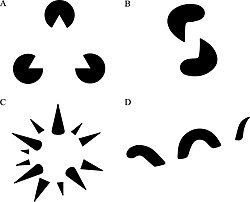How we see
| Art Appreciation and Techniques (#ART100) | |
|---|---|
| How art speaks: Finding meaning | Overview | Introduction | How we see | First level of meaning: Formal | Second level of meaning: Subject | Third level of meaning: Context | Fourth level of meaning: Iconography | Critical perspectives | Summary |
Let's begin to break down some barriers to find specific meaning in art, including those of different styles and cultures. To help in this journey we need to learn the difference between looking and seeing.
To look is to get an overview of your field of vision. Seeing speaks more to understanding. When we use the term “I see” we communicate that we understand what something means. With art, this may at first appear to be simple: separate out each element and discover how it is used in the work. Actually, there are some areas of learning that have looked at this very closely: particularly psychology and biology. In these areas, the fact that humans perceive flat images as having a "reality" to them is very particular. In contrast, if you show a dog an image of another dog, they neither growl nor wag their tail, because they are unable to perceive flat images as containing any meaning. So you and I have actually developed to be able to "see" images.
In addition, there is a cultural component in how we perceive images and that we do so in subjective ways. Seeing is partly a result of cultural biases. For example, when many of us from industrialized cultures see a parking lot, we can pick out each car immediately, while others from remote tribal cultures (who are not familiar with parking lots) cannot.Gestalt is the term we use to explain how the brain forms a whole image from many component parts. For instance, the understanding of gestalt is in part a way to explain how we have learned to recognize outlines as contours of a solid shape, allowing us to draw "space" using only lines.
The sites below have some fun perceptual games from psychology and science about how we see along with some further explanations of gestalt:
